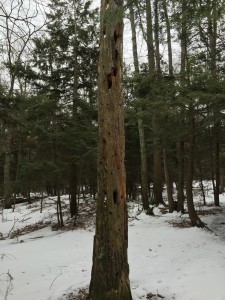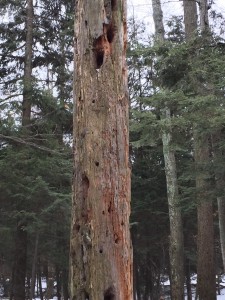Trees die all the time as a result of disease, lightning, fire, animal damage, too much shade, drought, root competition, as well as old age. Dead standing trees, called snags, are highly productive sources of habitat in natural areas and designed landscapes. In our desire to keep things neat and tidy, we usually cut these down and cart off the dead tree material. If the dead tree is sited where it can fall on property or injure someone, it should, of course, be taken down. But, if it is where it can cause no harm, strongly consider leaving it up for its wildlife value.
What Wildlife Value Do Snags Provide?
Snags provide habitat for hundreds of species of animals nationwide. For example, as trees die, they become home for myriad species of insects, fungi, lichens, and mosses. These, in turn, serve as food for higher order animals that eat them. For example, the outer surface of the bark is where birds such as nuthatches, and woodpeckers eat bark beetles, spiders, and ants. The inner bark is where woodpeckers eat larvae and pupae of insects. Mammals such as raccoon and black bear may tear into these areas of snags to harvest the protein-rich insects. The heartwood is where strong excavators such as the pileated woodpecker prey upon carpenter ants and termites. These sources of insect food are particularly important in winter when insect populations are at their nadir.
The holes woodpeckers make vary in size. Some will naturally enlarge due to the opening rotting thus providing habitat for an even greater number of species. In North America 55 avian species nest in cavities such as these. Eastern bluebirds, American kestrels, some species of owls, and wood ducks are examples of species that rely on cavities in dead wood for successful reproduction. Other birds, such as ruffed grouse, will use logs for drumming and courtship displays.
Hollow snags and large knot-holes are used by many species of mammals such as squirrels, porcupine, and raccoons. Bats nest and reproduce in the spaces under the bark where it is peeling off the tree. Amphibians, reptiles, and invertebrates seek refuge in natural cavities and dens.
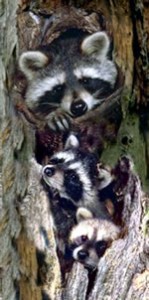 |
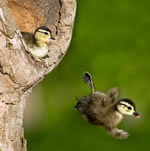 |
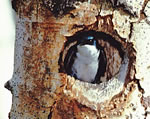 |
Often considered unsightly, snags support a wide range of wildlife that should compensate for our traditional notions of neatness. Nature does not abide by our aesthetics, but if you look beyond our surface representations of what looks good, you will find plenty to please the eye.
References used for this blog include:


